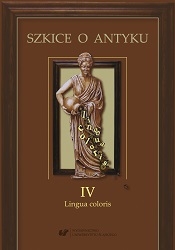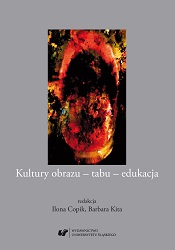
We kindly inform you that, as long as the subject affiliation of our 300.000+ articles is in progress, you might get unsufficient or no results on your third level or second level search. In this case, please broaden your search criteria.









This article briefly discusses the concept of color as a rhetorical term in Roman rhetorical literature. The term had several meanings: the style and character of work or speech, the stylistic device, the ornamentation or excuse and mitigating circumstance. A number of examples excerpted from Roman rhetoricians (especially from Cicero and Quintilian) and other authors which illustrate the above-mentioned meanings of this concept are quoted. Most attention, however, is devoted to the meaning of the term color in a type of declamation called controversia, in which it acquires the most technical sense: a brilliant turn in argumentation which, thanks to a skilful interpretation of facts, reduces or highlights the blame of an accused person. The term conceived in that way is usually associated with Seneca the Elder, the author of the work entitled „Oratorum et rhetorum sententiae, divisiones, colores”. Seneca not only lists examples of colores, excerpted from the other rhetorician's speeches, but also classifies and evaluates them, thus he becomes an important theoretician of the concept in question.
More...
The expressions which determine colours are indispensable element of the world description in Nemesianus’ Eclogues. Their specification provides further precious information about the models of perception and interpretation of the world presented in the works written by the Carthaginian poet in the third century A.D. I would like to show in what way mentioned poet exploits colours in the world representation. Carrying out research on the linguistic material I put great emphasis on updating linguistic and cultural connotations in one of the Carthaginian poet’s Eclogues. As far as the colours indicating is concerned, it is necessary to highlight its strong connection with social tradition embodied in the Latin poetry.
More...
This article presents chosen passages from Roman literature, in which color epithets are collocated with nouns such as e.g.: gladius, flagellum, arcus or hasta. The aim of the text is to outline variety of the mentioned collocations as well as to describe their functions and explain interpretative problems with reference to historical and traditional context. The main emphasis is put on a conviction that color in literature let a reader construe (through senses) world and visions created by authors. It is possible to highlight personal characteristic thanks to vivid depictions and metaphors. Furthermore, color itself can lead into space of surprising solutions, noteworthy ideas and unusual descriptions, which have an impact of readers’ imagination.
More...
In all the orphic gold tablets it is emphasized that the location of the fountain is indicated by a white cypress. What is new in the tablets is not so much the cypress, as the adjective by which it is qualified, λευκή, which means „shining” or „white”. Some authors have defended the translation „shining”, but the choice between „white’’ and „shining’’ is in fact a problem of our translations, not of the Greek term, which includes both notions simultaneously. I try to explain this question in my article.
More...
The article presents an analysis of some examples of the polychromed objects of ancient art like terracotta statuettes and white ground Greek vases, kept at the Princes Czartoryski Museum in Krakow. It contains also the results of chemical tests and an iconographic analysis of the scenes decorating the objects, leading to the confirmation that two of the white ground lekythoi were subject to thorough reconstruction of the layer of paint in 19th-century Athens.
More...
The colour programme of the Aleksander Mosaic has not been the subject of separate studies so far. Researchers take up this issue when analyzing the statements of Pliny (in his „Natural History”) about the palette of four colors and the so-called colores floridi and colores austeri. Assuming that the Mosaic is a copy of a lost painting of Philoxenus of Eretria, I try to prove that the use of four colors resulted from an artist’s assumption that the pigments must be subordinated to the whole composition and should not dominate it, which was a condition for a well-understood art of imitating of nature. This conviction is in line with the remarks of many ancient thinkers, including Aristotle, although – as Vitruvius and Pliny testify – it was not scrupulously kept by ancient painters.
More...
Chosen examples of the Pompeian paintings prove, that many ancient artists consciously used colour to create depth. Author analyses chiaroscuro, mythological scenes and landscapes with colour perspective, also called air perspective. Warm and dark colours are used to depict close objects, cold and bright ones to show illusion of depth. Term „air perspective’’ suggests, that such vision is being influenced by air masses between an object and an observer. In the Pompeian painting these rules are not used consequently. Linear perspective or different colours of females and males bodies also have influence on the space. Still, it’s worth to pay attention to innovativeness of ancient artists.
More...
The main topic of this paper is atramentum – pigment described by Pliny the Elder and Vitruvius, used in painting and architecture. Probably it was a secret of painter’s unusal achieves. The most possible is that he prepared his own atramentum from wax and burnt ivory. When I look at the paintings from Lefkadia or Kazanlak I suppose that atramentum in painter’s workshop was black but diluted atramentum became blue.
More...
The color of wine has crucial importance in relation to the quality of wine. Laboratory parameters of color are supervised by the International Organisation of Vine and Wine (OIV), and is intensity I and tonality T. It is also found that the subjective visual impression of the consumer is an important in the first step in his purchase. Consumer research survey, conducted in Australia in 2005–2007 on the 1643 wines, shows that red wines with greater color intensity are characterized by a higher class market. Color of the wine depends on many factors: the variety of grape, their ripeness, the winemaking processes, and age of wine. In the case of red wine, its color is given by anthocyanins, whose chemical properties are presented: their copigmanted complexes, also uncoloured cofactors capable to specific interactions and color changes in the environment of varying acidity of wine. That phenomenons are independent on time and were presented in ancient Greek wine like also all users of wine today, which is directly bind with tradition. Maybe the most different is mode and necessity of wines description. Knowledge about the nuances of color tonality, perception of wine and its origin is part of the oenological visual organoleptic analysis. The color perception is subjective and individual, and depends directly on the light conditions, but also of education, cultural background, experience, emotional state. Analysis of visual color of the wine contains the skills of perception, discernment and naming. These abilities can be educated and improved through education.
More...
This article aims to systematize the discussion of the problems of taboo in cinema against the work of Todd Solondz, with particular emphasis on film, „Storytelling” (2001) „Welcome to the Dollhouse” (1995), „Happiness” (1998) and „Palindromes” (2004). Article shows that in his artistic achievements director looks at topics strongly tabooed by contemporary culture, such as abortion, pedophilia, disability or domestic violence. Solondz not only tells the story marked in the subject, but also tames them, so that his heroes were able to arouse sympathy. The author showed that thanks to that the director forces the viewer to intellectual effort and self‑reflection. It proved also that in these films Todd Solondz deliberately exceed the limit fixed by the culture by breaking taboos, which, however, is not marked by obvious moral. In this way, the author shows educational dimension to the work of the director.
More...
In culture and cinema, pornography and eroticism are current issues which have never ceased to arouse profound emotions. This paper focuses particularly on pornography, nudity, and eroticism in Jean‑Luc Godard’s films with regard to the mainstream films, the latter ones absorbing pornography as cinema has changed whereas the cultural taboos have been broken down. For Godard, a director who is fond of identifying grave problems by means of shocking the audience, the aforementioned tropes are useful tools. Initially, Godard employs nudity in order to emphasise the commercialisation of the everyday life and the imperfection of the social relations based on production and exploitation. Since the 80s, he aims at reaching the mystery of the film image by means of almost pornographic frames. However, in Godard pornography loses its inherent pornographic effect: its frames are cold, boring, and repetitive; deprived of excitement, they connote nearly medical images. Considering the violence of the political states, totalitarian systems, and murders in general, what is, in fact, the rape on the screen or the rape of the screen? This is the question the director seems to pose.
More...
The article is an analysis of a debut, feature‑lenght film by Kuba Czekaj – Baby Bump in the perspective of transgression and Józef Kozielecki’s psychotransgression theory. Theses are based on symbolic (cutting off frozen ears, breasts, pregnancy belly; hatching) and formal (cartoon, pastel, surreal imagination) transgression indicators, which simultaneously realize the process of breaching of taboo of childhood limits. Conclusions are based on enhancers and impediments’ theory in progression’s psychology, which at the same time explain threads of fascination with corporealness, mother’s sexuality, maturation’s trauma which is intertwined with sexual normativeness.
More...